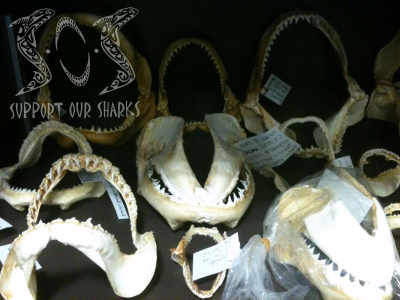If you went back in time and looked at the
first, unremarkable prehistoric sharks of the Devonian period (about
400 million years ago) you would never guess that their descendants
would become such dominant creatures, holding their own against
vicious aquatic reptiles like
pliosaurs and
mosasaurs and going on to become the "apex predators" of the
world's oceans.
Time Line of Shark Evolution
The First Sharks (The Devonian Era - 400 MYA)
Over 400 million years ago, innumerable species
of bony fish and marine organisms inhabited the Earths seas.
The time period, known in history as the Devonian Era, gave
birth to a family of fish unlike any other of the time, known as
Chondrichthyes (Cartilaginous fishes) (Huxley, 1880; Long, 1995).
The Chondrichthyes evolved a truly unique skeleton composed
almost completely of cartilage.
Divergent evolution began to further separate the
Chondrichthyans from the primitive fish, creating an array of beings
that would come to be known as the progenitors of all shark species
(Bonaparte, 1838).
Chondrichthyans are considered to have been highly advanced for
their time, possessing a great deal of the same characteristics seen
in modern cartilaginous species.
Now nearly 400,000 millennia on and evolution has generated
over 1,200 highly advance species of sharks and rays, encompassed
within the
Elasmobranchii (sharks, rays and skates) and
Holocephali (chimaeras, also known as ghost sharks),
which have all diverged from the Chondrichthyans (FAO species
catalogue, 2002).
Cartilaginous fish are so named because their
internal framework is composed of almost entirely of cartilage
rather than bone.
Cartilage, unlike bone, does not fossilize well when an animal dies.
The exposed collagen fibres in the cartilage degrade and
break apart, fragmenting the skeleton into thousands of pieces, and
leaving only teeth, scales and spines behind, making it extremely
difficult to determine when these organisms first appeared on earth.
Shark Fossils
In a historic scientific find last century,
scientists discovered several entire shark skeleton imprints dating
back to the mid-Devonian Era, persevered in the Cleveland Shales in
the  Remnants of
fish fossilized swallowed hole, tail first are indicative of this
early sharks speed and agility.
The teeth of Cladoselache also displayed similarities in
structure to modern sharks.
They had a shallow root and a crown with a central cusp
flanked by two smaller cusps, designed to prey on small fish.
Unlike most modern and ancient sharks, Cladoselache was
almost completely devoid of scales, with exception of a few cusped
scales on the edges of the fins, mouth and eyes.
One particular characteristic of Cladoselache that was
unusual for a shark of that time was that it lacks claspers.
The claspers are organs that transfer sperm during
copulation. Claspers
were present on most early sharks, including Xenocanths, and evident
on all modern shark species.
Also Cladoselache had a jaw that was fused with the cranium
under the snout and the eye.
Modern sharks have a hinged jaw that is connected the skull
through several series of ligaments.
The latest fossil of Cladoselache led scientists to believe
that it went extinct about 250 million years ago (Zangerl, 1981).
Remnants of
fish fossilized swallowed hole, tail first are indicative of this
early sharks speed and agility.
The teeth of Cladoselache also displayed similarities in
structure to modern sharks.
They had a shallow root and a crown with a central cusp
flanked by two smaller cusps, designed to prey on small fish.
Unlike most modern and ancient sharks, Cladoselache was
almost completely devoid of scales, with exception of a few cusped
scales on the edges of the fins, mouth and eyes.
One particular characteristic of Cladoselache that was
unusual for a shark of that time was that it lacks claspers.
The claspers are organs that transfer sperm during
copulation. Claspers
were present on most early sharks, including Xenocanths, and evident
on all modern shark species.
Also Cladoselache had a jaw that was fused with the cranium
under the snout and the eye.
Modern sharks have a hinged jaw that is connected the skull
through several series of ligaments.
The latest fossil of Cladoselache led scientists to believe
that it went extinct about 250 million years ago (Zangerl, 1981).
The Carboniferous Era (320 MYA)
During the Carboniferous era, 320 million years
ago, most of present day Europe and
The Hybodontidae came into existence in the
Carboniferous era and may be considered a more immediate ancestor to
modern sharks. They
possessed many key similarities, including copulatory claspers,
which the more primitive Cladoselache did not (Romer and Williams,
1976). The Hybodonts
became the dominant group during the Mesozoic Era spanning the late
Permian to the Jurassic period (220 to 65 million years ago).
The Hybodus was a common genus of the Hybodont group and is
the oldest known representative of the order Selachii (Romer and
Williams, 1976). Its fin
orientation and body structure may show links between the more
primitive Cladoselachii order and Neoselachii or modern sharks such
as the bullhead (Heterodontus).
The Hybodontidae are believed to have become extinct about
the same time as the dinosaurs, around 65 million years ago (Romer
and Williams, 1976).
Scientists have also found fossils of mako and mackerel sharks
dating back to the late Jurassic period, putting the arrival of most
modern sharks somewhere in the lower Cretaceous period (130- 60
million years ago) (Long, 1995).
Neoselachian Radiation
Two palaeontologists, Detlev Thies and
Wolf-Ernst Reif, proposed the theory of Neoselachian radiation,
which stated that the development of the modern shark or
Neoselachian was the result of an opportunistic response to an
abundant new food source (Thies and Reif, 1985).
Populations of these new bony fish exploded in the seas
providing plenty of food to predators that possessed the speed,
flexible jaws and manoeuvrability necessary to catch them (Thies and
Reif, 1985). Thies and
Reif (1985) went on to suggest that these sharks began to branch off
from near-shore hunting and began competing with the large marine
reptiles of the time in pelagic predation.
Jurassic Explosion (100 MYA)
The Jurassic Explosion, beginning approximately
100 million years ago, marked the emergence of thousands of shark
that slowly evolved into the species that we see today including the
great white (Carcharodon carcharias).
Around 65 to 60 million years ago, the white shark,
Carcharodon carcharias arrived (Long, 1995).
The white sharks were born into existence so highly evolved
for their niche on the Earth that they have hardly been altered by
nature. The great whites
seen today are virtually a mirror image of the white shark of the
late-Jurassic/ early Tertiary period.
Megalodon (60 MYA)
Also around this time (60- 55 million years
ago) the greatest of all sharks inhabited the Earth, Carcharodon
megalodon. C.
megalodon was the biggest predator known to have existed in
the oceans of the planet (Applegate and Espinosa-Arrubarrena, 1996).
The immense beast could reach 65 feet in length and could
weigh 30 tons, comparable to an average-sized sperm whale.
The teeth of C. megalodon closely resembled that of
its smaller cousin the white shark, but three times the size, over 6
inches long. Due to
similarities in serrated edges and size of the teeth, a popular
theory emerged that the white shark and C. megalodon were
very closely related, if not actually representative of the same
species (Ferrari and Ferrari, 2002).
The theory suggested that due to a reduction in prey size,
C. megalodon became smaller eventually evolving into the great
white shark (Ferrari and Ferrari, 2002).
Currently a new popular theory maintains that the two
enormous predators diverged from a common line and one containing
C. megalodon became extinct and the other has survived to this
day (Ferrari and Ferrari, 2002).
Others still think that it is possible that C. megalodon
may still inhabit the most remote parts of the oceans.
Scientists have also found partially fossilized giant teeth
of C. megalodon at great depths of the ocean causing some to
believe that C. megalodon was still alive 2 million years ago
(Applegate and Espinosa-Arrubarrena, 1996).
Today
Not long ago it was commonly accepted that
sharks were simply primitive, mindless predators.
We now know that this couldn’t be further from the truth.
Humans have recently come to appreciate sharks for their long
history and deep ancestry.
Sharks have evolved from modest means hundreds of millions of
years ago, to the present day apex predators of the sea.
The fact that many modern shark species evolved several
million years ago and have remained unchanged in all that time goes
to show how efficient and well adapted these creatures are to their
environment. During the
millions of years of evolution, the present day Chondrichthyes have
developed some of the most sophisticated hunting systems ever known
(Bright, 1999). The
success of the Chondrichthyes as predators is largely due to their
highly developed sensory systems (Bozzano and Colin, 2000).
